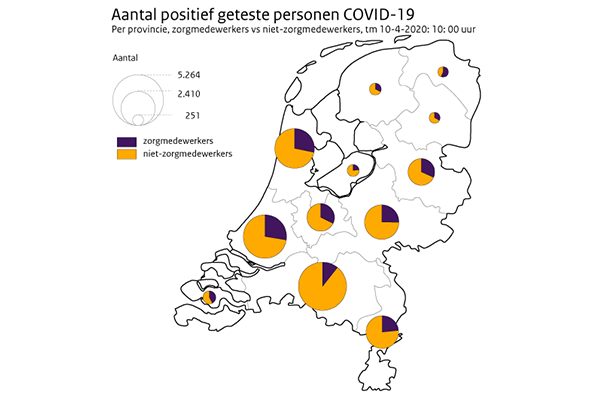
There are significant regional differences in the coronavirus epidemic in the Netherlands. This is also the case in the distribution between the number of confirmed cases among healthcare workers and other patients.
Regional differences in the epidemic
There are significant regional differences in the epidemic. In the Netherlands, up to 23,097 confirmed cases have been reported so far. Most confirmed coronavirus cases live in the province of Noord-Brabant. Almost a quarter of the total number of confirmed cases in the Netherlands concern residents of the province of Noord-Brabant (5,264 confirmed cases). The province of Groningen with 251 confirmed cases is the province with the lowest number of cases, 1,1 per cent of the total number of cases, closely followed by the provinces of Drenthe (274 cases, 1,2 per cent), Friesland (326 cases, 1,4 per cent) and Flevoland (328 cases, 1,4 per cent).
These differences can be explained by the fact that the novel coronavirus is not equally spread throughout the Netherlands. In Noord-Brabant, the epidemic seems to be flattening. The number of reported cases in the north of the Netherlands is steadily low.
Healthcare workers
The distribution between the number of confirmed COVID-19 cases of healthcare workers and other patients varies significantly per region. This depends on the degree of spread of the coronavirus and the local testing policy until 6 April. For example, 56% of all reports from Groningen originate from healthcare workers. In Noord-Brabant, this is 11% of the reports to date. Nationwide, 24% of confirmed COVID-19 cases is a healthcare professional.
The map shows the proportion of reported healthcare workers per province compared to other patients.
Testing policy
More tests have been carried out since 6 April. The extension of testing is intended for care workers outside the hospital, such as general practitioners, nursing home workers, disabled care workers or home care workers. Also, more patients are being tested with a high risk of a severe course of coronavirus infection, such as the elderly and people with severe underlying health conditions or disorder. See also ‘Policy on testing for novel coronavirus disease (COVID-19)’.
